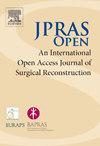Role of residual mandibular teeth after computer-assisted mandibular reconstruction using a fibular flap
IF 1.5
Q3 SURGERY
引用次数: 0
Abstract
Background
Computer-assisted mandibular reconstruction after mandibulectomy enables accurate reconstruction of the occlusal positions between the maxilla and mandible. Understanding the remaining teeth condition is essential for sensory mastication in patients with numerous tooth loss. However, no studies have examined the dental status of the remaining mandible after computer-assisted mandibular reconstruction using a fibular flap. This study evaluated the role of residual teeth and other factors in effective acquisition of oral intake after computer-assisted mandibular reconstruction using a fibular flap.
Patients and Methods
Postoperative oral intake and associated factors were retrospectively examined in 57 consecutive patients. Oral intake was assessed using the Functional Oral Intake Scale. Multivariate analysis was performed to evaluate the remaining teeth arrangement (Eichner's classification), mandibular dentures, extent of resection (Brown's classification), age, performance of glossectomy, history of radiation therapy, and computer-assisted methods.
Results
Multivariate analysis revealed that Eichner's classification had a positive (p<0.001) and radiation therapy had a negative (p<0.05) impact on oral intake. The patients with dentures anchored to the remaining teeth in the occlusal support area (i.e., premolar and molar) had higher Functional Oral Intake score than those with dentures anchored to the remaining teeth in the non-occlusal support area (6.78±0.03 vs. 6.10±0.07, p<0.005).
Conclusion
In computer-assisted mandibular reconstruction with accurate occlusion, the residual teeth in the occlusal support area are essential for good postoperative oral intake with dentures. During mandibulectomy, if oncologically acceptable, these teeth should be preserved, and selective placement of dental implants in the occlusal support area should be considered.
使用腓骨瓣进行计算机辅助下颌骨重建后残留下颌牙的作用
背景下颌骨切除术后的计算机辅助下颌骨重建可以准确重建上颌骨和下颌骨之间的咬合位置。了解剩余牙齿的状况对大量牙齿缺失患者的感觉咀嚼至关重要。然而,目前还没有研究对使用腓骨瓣进行计算机辅助下颌骨重建后剩余下颌骨的牙齿状况进行研究。本研究评估了残留牙齿和其他因素在使用腓骨瓣进行计算机辅助下颌骨重建后有效获得口腔摄入量中的作用。患者和方法对 57 名连续患者的术后口腔摄入量和相关因素进行了回顾性研究。口腔摄入量采用功能性口腔摄入量表进行评估。结果多变量分析显示,Eichner 分级对口腔摄入量有积极影响(p<0.001),而放射治疗对口腔摄入量有消极影响(p<0.05)。与将假牙固定在非咬合支持区剩余牙齿上的患者相比,将假牙固定在咬合支持区剩余牙齿上的患者(6.78±0.03 vs. 6.10±0.07,p<0.005)具有更高的功能性口腔摄入评分。在下颌骨切除术中,如果肿瘤学上可以接受,应保留这些牙齿,并考虑有选择性地在咬合支持区植入种植体。
本文章由计算机程序翻译,如有差异,请以英文原文为准。
求助全文
约1分钟内获得全文
求助全文
来源期刊

JPRAS Open
Medicine-Surgery
CiteScore
1.60
自引率
0.00%
发文量
89
审稿时长
22 weeks
期刊介绍:
JPRAS Open is an international, open access journal dedicated to publishing case reports, short communications, and full-length articles. JPRAS Open will provide the most current source of information and references in plastic, reconstructive & aesthetic surgery. The Journal is based on the continued need to improve surgical care by providing highlights in general reconstructive surgery; cleft lip, palate and craniofacial surgery; head and neck surgery; skin cancer; breast surgery; hand surgery; lower limb trauma; burns; and aesthetic surgery. The Journal will provide authors with fast publication times.
 求助内容:
求助内容: 应助结果提醒方式:
应助结果提醒方式:


